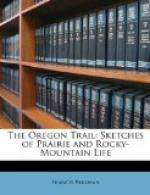The country before us was now thronged with buffalo, and a sketch of the manner of hunting them will not be out of place. There are two methods commonly practiced, “running” and “approaching.” The chase on horseback, which goes by the name of “running,” is the more violent and dashing mode of the two. Indeed, of all American wild sports, this is the wildest. Once among the buffalo, the hunter, unless long use has made him familiar with the situation, dashes forward in utter recklessness and self-abandonment. He thinks of nothing, cares for nothing but the game; his mind is stimulated to the highest pitch, yet intensely concentrated on one object. In the midst of the flying herd, where the uproar and the dust are thickest, it never wavers for a moment; he drops the rein and abandons his horse to his furious career; he levels his gun, the report sounds faint amid the thunder of the buffalo; and when his wounded enemy leaps in vain fury upon him, his heart thrills with a feeling like the fierce delight of the battlefield. A practiced and skillful hunter, well mounted, will sometimes kill five or six cows in a single chase, loading his gun again and again as his horse rushes through the tumult. An exploit like this is quite beyond the capacities of a novice. In attacking a small band of buffalo, or in separating a single animal from the herd and assailing it apart from the rest, there is less excitement and less danger. With a bold and well trained horse the hunter may ride so close to the buffalo that as they gallop side by side he may reach over and touch him with his hand; nor is there much danger in this as long as the buffalo’s strength and breath continue unabated; but when he becomes tired and can no longer run at ease, when his tongue lolls out and foam flies from his jaws, then the hunter had better keep at a more respectful distance; the distressed brute may turn upon him at any instant; and especially at the moment when he fires his gun. The wounded buffalo springs at his enemy; the horse leaps violently aside; and then the hunter has need of a tenacious seat in the saddle, for if he is thrown to the ground there is no hope for him. When he sees his attack defeated the buffalo resumes his flight, but if the shot be well directed he soon stops; for a few moments he stands still, then totters and falls heavily upon the prairie.
The chief difficulty in running buffalo, as it seems to me, is that of loading the gun or pistol at full gallop. Many hunters for convenience’ sake carry three or four bullets in the mouth; the powder is poured down the muzzle of the piece, the bullet dropped in after it, the stock struck hard upon the pommel of the saddle, and the work is done. The danger of this method is obvious. Should the blow on the pommel fail to send the bullet home, or should the latter, in the act of aiming, start from its place and roll toward the muzzle, the gun would probably burst in discharging. Many a shattered hand and worse casualties besides have been the result of such an accident. To obviate it, some hunters make use of a ramrod, usually hung by a string from the neck, but this materially increases the difficulty of loading. The bows and arrows which the Indians use in running buffalo have many advantages over fire arms, and even white men occasionally employ them.




